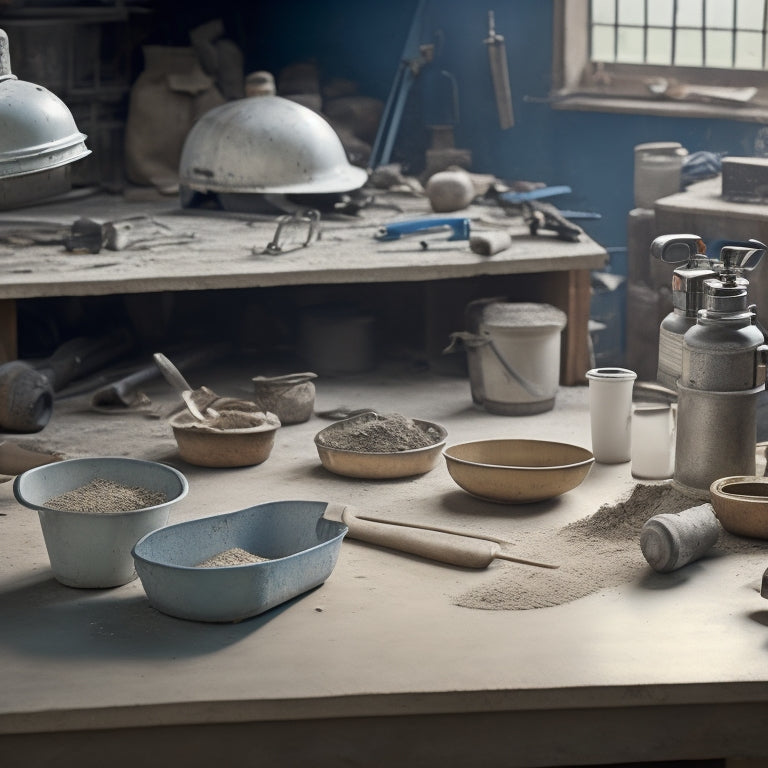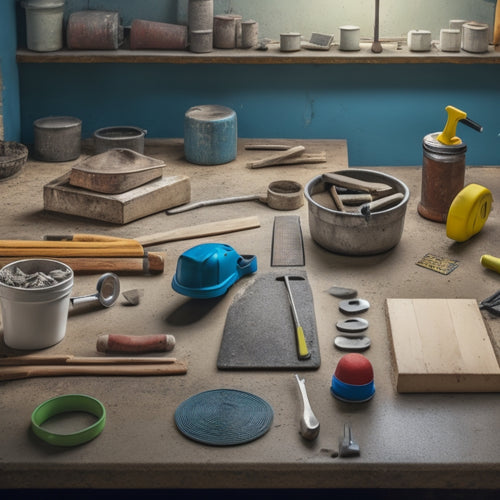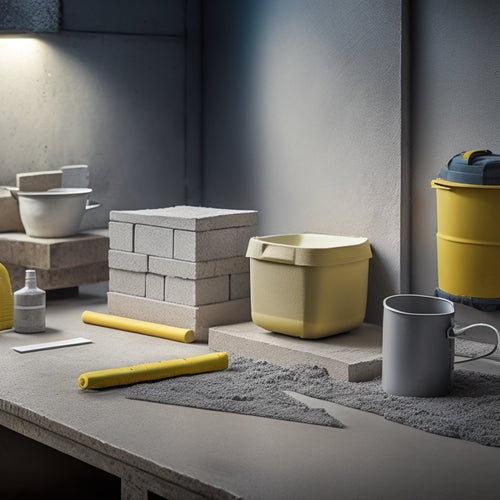
What Tools Do You Need for Concrete Success
Share
For concrete success, you'll need a range of essential power tools, including rotary hammers, angle grinders, concrete saws, and hammer drills. Impact drivers will help you mix materials up to three times faster, while regular tool maintenance is vital to prolong their lifespan. Additionally, concrete mixing techniques and equipment, such as drills with variable speed triggers and adjustable torque settings, will help you achieve the perfect consistency. And don't forget safety gear, like protective gloves and respirators, to guarantee a safe working environment. As you explore these tools and techniques, you'll reveal the secrets to efficient and high-quality concrete projects.
Key Takeaways
• Essential power tools for concrete projects include rotary hammers, angle grinders, concrete saws, hammer drills, and impact drivers.
• Proper tool maintenance is crucial, including regular cleaning, lubrication, and storage to prolong tool lifespan.
• Achieving the right consistency in concrete mixing involves testing flow, slump, and viscosity, and balancing moisture levels for workability and durability.
• Drill bit selection is critical, considering factors like bit type, material, durability, and corrosion resistance to match project needs.
• Safety gear is vital, including protective gear, respirators, and high-visibility vests to prevent injuries and ensure a safe working environment.
Essential Power Tools Needed
What're the essential power tools you'll need to tackle concrete projects efficiently and effectively?
To get the job done right, you'll need a solid arsenal of power tools that can handle the demands of concrete work. First and foremost, you'll need a reliable rotary hammer or demolition hammer for breaking up and demolishing concrete.
A high-powered angle grinder is also a must-have for grinding and polishing concrete surfaces. Additionally, a concrete saw or cutoff saw is necessary for cutting through concrete pipes or slabs. Don't forget a sturdy drill with a hammer drill bit for drilling into concrete.
To keep your tools in top condition, prioritize power tool maintenance. Regularly clean and lubricate your tools, and store them in a dry, protected area.
Invest in tool storage solutions like chests or cabinets to keep your tools organized and within reach. By having the right power tools and taking care of them, you'll be able to tackle even the toughest concrete projects with confidence and efficiency.
Mixing Concrete Quickly and Efficiently
When you're working with concrete, you know that achieving the right consistency is critical to a successful pour.
To get it just right, you need to mix it quickly and efficiently, without sacrificing quality.
Right Consistency Matters
You need to achieve the right consistency in your concrete mix to guarantee a strong and durable final product, and that starts with mixing it quickly and efficiently. The ideal consistency is essential, as it directly affects the concrete's workability, strength, and overall quality.
To get it right, you need to perform consistency testing, which involves evaluating the mix's flow, slump, and viscosity. This can be done using various tools, such as a slump cone or a flow table.
Moisture measurement is also vital, as excess water can lead to a weak and porous concrete. You can use a moisture meter to determine the best water content for your mix. By controlling the moisture levels, you can achieve the perfect balance between workability and strength.
Mixing Time Savers
Frequently, contractors and construction teams rely on advanced mixing technologies to considerably reduce mixing time and guarantee consistent results. You can save time and improve the quality of your concrete mix by implementing efficient mixing techniques.
One way to do this is by using mixing additives that accelerate the hydration process, allowing you to mix and pour concrete faster. Additionally, optimizing your batch sizes can also help reduce mixing time. By mixing in smaller batches, you can avoid over-mixing and reduce the risk of concrete segregation.
To take it a step further, contemplate investing in automated mixing systems that can accurately measure ingredients and mix them to the perfect consistency. These systems can also help you maintain consistent results, even when working with large batches.
By streamlining your mixing process, you'll be able to complete projects faster and with greater accuracy. With the right tools and techniques, you'll be able to mix concrete quickly and efficiently, saving you time and resources in the long run.
Drills for Concrete Mixing Tasks
When it comes to drills for concrete mixing tasks, you'll want to focus on two key factors: selecting the right drill bit for the job and mastering speed and torque control.
By choosing a drill bit that can handle the demands of concrete mixing, you'll guarantee a smooth and efficient process.
Now, let's take a closer look at how to make the most of these critical components.
Drill Bit Selection
Selecting the right drill bit is vital for efficient concrete mixing, as it directly impacts the quality of the mix and the overall productivity of the task. You need to choose a drill bit that can effectively break down aggregates, mix cement, and blend additives.
There are various drill bit types to take into account, including spiral bits, paddle bits, and turbo mixer bits. Each type is designed for specific mixing tasks, so it's important to match the bit to your project's requirements.
Drill bit materials also play a significant role in concrete mixing. You'll typically find bits made from high-speed steel (HSS), tungsten carbide (TC), or diamond-coated materials. HSS bits are suitable for general-purpose mixing, while TC bits offer superior durability and resistance to wear.
Diamond-coated bits are ideal for heavy-duty mixing and provide exceptional lifespan. When selecting a drill bit, evaluate the material's strength, durability, and resistance to corrosion.
Speed and Torque Control
You need to pair your drill bit with a drill that provides ideal speed and torque control to achieve the perfect mix, as excessive speed can lead to uneven mixing and wear on the bit.
A drill with variable speed adjustments allows you to fine-tune the speed to suit the specific mixing task, guaranteeing a uniform blend of concrete. Furthermore, precise torque settings prevent the drill from stalling or over-torquing, which can damage the bit or the drill itself.
To achieve optimal speed and torque control, consider the following:
-
Variable speed triggers: Look for drills with triggers that allow you to adjust speed on the fly, giving you more control over the mixing process.
-
Torque settings: Opt for drills with adjustable torque settings to prevent over-torquing and guarantee the drill bit is protected from excessive force.
-
Digital displays: A drill with a digital display showing speed and torque readings helps you monitor and adjust your settings for optimal performance.
Hammer Drills for Heavy Mixing
Two hammer drills are essential for tackling heavy mixing jobs: a rotary hammer drill for large batches and a hammer drill with a mixing paddle for smaller, more precise tasks.
When working with heavy mixes, you'll appreciate the extra power and control these drills provide. To get the most out of your hammer drills, prioritize drill maintenance. Regularly clean and lubricate the drill bits, and store them properly to prevent damage.
Additionally, develop mixing techniques that work best for your specific projects. For instance, start by mixing smaller batches and gradually increase the size as needed. This approach helps prevent overmixing, which can lead to weakened concrete.
When using your rotary hammer drill, focus on efficient mixing techniques to avoid fatigue. Hold the drill at a 45-degree angle and apply gentle to moderate pressure, depending on the mix's consistency.
For smaller, more precise tasks, switch to your hammer drill with a mixing paddle. This drill is ideal for mixing small batches of concrete or mortar, and its paddle attachment helps to scrape the sides and bottom of the mixing bucket.
Impact Drivers for Fast Mixing
As you move beyond heavy mixing tasks, you'll find that impact drivers are the perfect tool for fast mixing, allowing you to tackle smaller, high-volume projects with speed and efficiency.
Impact drivers offer several advantages over traditional mixing methods, making them an essential tool for any concrete professional.
Here are three key benefits of using impact drivers for fast mixing:
-
Increased Speed: Impact drivers can mix materials up to 3 times faster than traditional mixing methods, allowing you to complete projects quickly and efficiently.
-
Improved Consistency: Impact drivers guarantee consistent mixing, reducing the risk of unevenness and improving the overall quality of your concrete.
-
Reduced Fatigue: Impact drivers take the strain out of mixing, reducing operator fatigue and allowing you to work for longer periods without exhaustion.
Right Angle Drills for Tight Spaces
When working in tight spaces, right angle drills become an indispensable tool, allowing you to access areas that are difficult or impossible to reach with traditional drills. These specialized drills are designed to navigate corners, crevices, and other confined spaces with ease. Their compact design makes them perfect for working in tight spots, such as drilling anchor holes in concrete foundations or installing pipes in cramped mechanical rooms.
Look for right angle drills with ergonomic features that reduce fatigue and improve control. A comfortable grip and adjustable handle will help you maintain precision and accuracy, even in the most challenging spaces. Additionally, consider a drill with an adjustable head that can be positioned at various angles, allowing you to access areas that would be impossible to reach with a traditional drill.
With the right right angle drill, you'll be able to tackle projects that would otherwise be impossible. Whether you're a seasoned contractor or a DIY enthusiast, having the right tools for the job is essential. By investing in a high-quality right angle drill, you'll be able to take on even the most complex projects with confidence.
Concrete Mixers for Large Quantities
You'll need a concrete mixer capable of handling large quantities to keep your project moving efficiently, especially when working with foundations or large slabs that require massive amounts of concrete.
Portable concrete mixers are an excellent option for large-scale projects, as they can be easily moved around the site and can handle significant volumes of concrete.
Here are three key factors to take into account when selecting a concrete mixer for large quantities:
-
Capacity: Verify the mixer can handle the volume of concrete you need for your project.
-
Power: Choose a mixer with sufficient power to mix the concrete efficiently and consistently.
-
Reliability: Opt for a mixer from a reputable manufacturer, and follow mixer maintenance tips to extend its lifespan and prevent downtime.
Trowels for Finishing Touches
Select the right trowel for the job to guarantee a professional finish, as this versatile tool is essential for smoothing, shaping, and texturing freshly poured concrete. You'll need to take into account the type of concrete, the desired finish, and the scale of the project when choosing the perfect trowel.
| Trowel Type | Trowel Materials | Trowel Techniques |
|---|---|---|
| Finishing Trowel | Stainless Steel, Aluminum | Smooths and flattens concrete, creates a high-gloss finish |
| Notched Trowel | Carbon Steel, Fiberglass | Adds texture and pattern to concrete, ideal for decorative finishes |
| Pool Trowel | Stainless Steel, Epoxy Coated | Designed for curved and irregular surfaces, perfect for pool decks and coping |
Mastering trowel techniques takes practice, but with the right tool, you'll be well on your way to achieving a flawless finish. From feathering edges to creating intricate patterns, the right trowel will help you bring your concrete vision to life. Remember to always clean and maintain your trowel to promote peak performance and extend its lifespan. By selecting the right trowel and honing your skills, you'll be able to achieve professional-grade results that will impress even the most discerning clients.
Safety Gear for Concrete Handling
Protect yourself from concrete's harsh chemicals and abrasive particles by donning the right safety gear before handling freshly poured concrete. You can't afford to take any chances when working with this unforgiving material.
Here are the essential safety gear you should wear:
-
Protective gloves and knee pads to shield your skin from abrasion and cuts.
-
Safety goggles and ear protection to prevent eye and ear damage from flying particles and loud machinery.
-
Hard hats, concrete boots, and high visibility vests to protect your head, feet, and increase visibility on the job site.
Additionally, consider wearing respirators to filter out harmful dust and particles.
Remember, safety gear isn't optional; it's a necessity when working with concrete. By wearing the right gear, you'll be able to focus on getting the job done efficiently and effectively, without compromising your health and well-being.
Don't take shortcuts – prioritize your safety above all else.
Frequently Asked Questions
Can I Mix Concrete in Small Batches for Small Projects?
You can definitely mix concrete in small batches for small projects, and it's often a good idea to do so.
By mixing in smaller batch sizes, you'll have better control over the mixing techniques, ensuring a more consistent finish.
Start by calculating the exact amount of concrete you need, then mix it in batches of 1-2 cubic feet.
This approach will help you avoid waste and achieve professional-looking results.
How Do I Clean My Tools After Working With Concrete?
Are you prepared to deal with the aftermath of working with concrete?
Cleaning your tools is essential for tool maintenance and extending their lifespan. Don't let concrete residue dry and harden on your tools - it's a nightmare to remove!
Immediately wash your tools with soap and water, then scrub off any remaining residue with a wire brush.
Dry them thoroughly to prevent rust. By doing so, you'll guarantee your tools are ready for the next project.
What Is the Ideal Temperature for Mixing and Pouring Concrete?
When mixing and pouring concrete, you're aiming for best conditions.
The ideal temperature range is between 50°F and 70°F (10°C and 21°C). Anything outside this range can affect the concrete's setting time and strength.
Be mindful of weather impact, as high winds, direct sunlight, or extreme temperatures can compromise the pour.
Adjust your mixing and placement schedule accordingly to guarantee a successful outcome.
Can I Use a Drill as a Substitute for a Concrete Mixer?
You're wondering if you can use a drill as a substitute for a concrete mixer?
While a drill can be used for small batches, its limitations become apparent when mixing large quantities.
The drill's mixing techniques can't compare to a dedicated mixer's ability to thoroughly combine and aerate the concrete.
You'll end up with an inconsistent mix, leading to weak spots and potential failures.
It's better to invest in a proper mixer for reliable results.
How Long Does It Take for Concrete to Fully Cure?
'Rome wasn't built in a day,' and neither is concrete fully cured in an instant.
When it comes to the curing process, you'll need patience. The curing time depends on various factors, including the type of cement, environmental conditions, and mix design.
On average, it takes around 28 days for concrete to fully cure, but it can range from 14 to 90 days.
You'll need to monitor the curing process closely to guarantee ideal strength and durability.
Conclusion
You've got the blueprint, the materials, and the will to create something concrete.
Now, it's time to gear up for concrete success! With these essential power tools, you'll be mixing, drilling, and finishing like a pro.
As you conquer each project, remember, you're building a legacy, brick by brick - or rather, concrete slab by concrete slab.
So, don your hard hat, fire up your tools, and let the concrete jungle rise!
Related Posts
-

Must-Have Tools for Laying Concrete Tiles
When laying concrete tiles, you'll need a range of essential tools to get the job done right. Start with subfloor pre...
-

Top Concrete Resurfacing Tools for a Pro Finish
When it comes to achieving a professional finish in concrete resurfacing projects, you require the right set of speci...
-

What Tools Do I Need for Concrete Block Laying
You'll need a thorough set of tools to guarantee accurate, efficient, and professional concrete block laying. Essenti...


